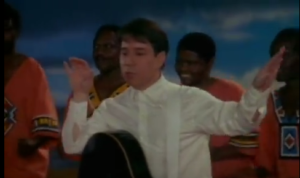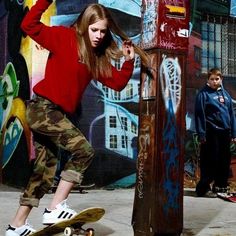Of Teaspoons and Waves
By Randall Auxier
 Paul Simon wrote (over a happy chord and floating rhythm) “she makes the sign of a teaspoon, he makes the sign of a wave.” That’s cryptic. But we see it here, in the video. What does that sign mean? These two people seem to understand, after he puts on aftershave and they spend a night sleeping in a doorway on Upper Broadway. At first she has diamonds on the soles of her shoes and he’s “empty as a pocket.” By the end, he has traded his sanity for diamonds on the soles of his own shoes. Holy cod. I haven’t ever been in that particular romance, but I think I know some who have.
Paul Simon wrote (over a happy chord and floating rhythm) “she makes the sign of a teaspoon, he makes the sign of a wave.” That’s cryptic. But we see it here, in the video. What does that sign mean? These two people seem to understand, after he puts on aftershave and they spend a night sleeping in a doorway on Upper Broadway. At first she has diamonds on the soles of her shoes and he’s “empty as a pocket.” By the end, he has traded his sanity for diamonds on the soles of his own shoes. Holy cod. I haven’t ever been in that particular romance, but I think I know some who have.
This is another story about how we begin to remember. There was this girl people called crazy. But there’s something different about her. Creativity is like that, like those diamonds. And poor boys know their ordinary shoes, put on aftershave to compensate. They want some of that action, some of that freakish light that only glints and glimmers and glitters in that crazy girl’s transient steps. You gotta take that gal dancing. Watch the shoes. There is an idea here.
This will now seem like a jarring change, but trust me.
The line goes: “Life’s like this: You fall and you crawl and you break and you take what you get and you turn it into honesty.” Avril Levigne‘s friends smash up a mall because it isn’t reality, and they are surprisingly realistic about what a working class kid can expect. They demand that whatever comes at you, your job is to be authentic. And have some fun, by the way.
So which will it be? Will you go crazy for your aesthetic vision, like Paul, or will you relax because it’s all been done before, as the Canadian kid counsels? Will you try to be somebody else, get some of those diamonds, or will you let it be? So many questions, so little time to watch YouTube.
Crispin Sartwell suggests that our love of beauty, when we turn ideas into ideals, gets locked into an unhealthy dance with perfection. It’s our inner Platonist becoming tyrant over the to kalon, beauty. No sooner do we imagine what is than we set about perfecting it to match that sweet imagination. And having perfected it we can’t measure up and want nothing better than to be free of whatever we have created. The perfect is the enemy of the good enough. But after you’ve been around the block on this paradox a few times, well, wherever you are, you want to be elsewhere . . .
It reminds me of that “blonde joke” (told me by my blonde wife who finds these jokes very funny): a man comes to a river bank, looks left and right and sees no bridge. But there is a blonde across the river, so he yells “how do you get to the other side?” There is a pause. Then the blonde yells back “you are on the other side . . . ” Then she makes the sign of a teaspoon. (I added that myself, but hey, maybe she does.) And here we have a clue about how to be released from our ideals, when they ensnare us.
There are two possibilities. First, learn to be where and when you are, “when you’re drivin’ in your car, one on one,” and don’t become somebody else, unless you want to frustrate your unimaginative skatepunk girlfriend. (To be fair, Avril never liked that song . . . at least so she said after it put diamonds on the soles of her shoes.)
The second option is the freakish decompensation. We take the Seventh Avenue Line to the doorways of Upper Broadway and swear off what the world may think. If we can’t find the dance club, we just sleep with the freaks. We embrace our own special insanity, with those who can share it. People look at us and make the sign of a wave.
In 1932, Tod Browning, after he got his own sole-diamonds for his acclaimed film Dracula, had a moment of insanity that became an impossible aesthetic project, a film called Freaks. His idea was to employ the actual freaks who were working in the sideshows of his times, the “midgets” and “human caterpillars” and “pinheads” and “conjoined twins” who had reminded the grandfathers of Kansas and the suicidal wolves of Wall Street that not every life can be idealized. Sometimes we fall and we crawl and we take what we get and turn it into . . . well . . . a closer and more honest look at the human condition.
So Browning put the freaks in a scripted film. It should have been called “Revenge of the Freaks,” perhaps. It was widely banned as unfit to watch. They sort of smashed up the mall, those freaks. “If you offend one of them, you offend them all,” the ominous voice says in the trailer. It’s not sweet imagination, it’s the back side of the ideal, in black and white. Paul Simon’s video for “Diamonds” shifts constantly between scenes of making the video and the video they made. The first is “reality” in black and white, and the second is sweet imagination in Kodachrome color, the idea made artistically into an ideal. But Paul still can’t dance. There is a freak hiding in there, and the freak’s still got those the walking blues. Watch the video.
These paradoxes are monsters of our own passion. Sartwell observes that we chain ourselves to anything that takes possession of our imaginations. Eventually we must decide whether we want a Kodachrome dream or a B&W life. In the second “after it rains, there’s a rainbow, and all of the colors are black; it’s not that the colors aren’t there, it’s imagination they lack.” The first world is nice bright colors, the greens of summers, to make us think all the world’s a sunny day, how it looks from behind the Nikon camera of sweet imagination. It’s understandable if we prefer it. I mean, everything looks worse in black and white, right?
In the Concert in Central Park, in front of half a million people, Paul Simon decided to reverse himself and sing “everything looks better in black and white.” I don’t like it when people read over-analyze song lyrics, but that change was a conscious decision.
The black and white world, devoid of Kodachrome and all it symbolizes, is like Avril’s smashed mall. No illusions, dude. Sometimes we want to be freaks and to see freaks, and that’s exactly the world as it is. Life’s like this, she said. When we substitute our imaginations, our personal Kodachrome, we put on preppy clothes, pretend the rainbow isn’t black.
Beautiful word-images by any standard. Ironically, they are made real by being presented as unreal. Look, that white boy has ordinary shoes and can’t dance. It’s good that he doesn’t try very often. That would be freakish. But maybe we could put the empty boy on a skateboard . . . I think I saw Avril make the sign of a teaspoon somewhere in that video. Can I make it any more obvious? As if anybody here would know exactly what I was talking about? Well, I guess every generation throws a hero up the pop charts. But maybe she’s just trying to keep her balance. Maybe that isn’t the teaspoon sign after all. Nice colors though.

